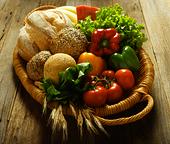Just like an artist, you can be creative and inspired while you’re in the kitchen creating your next meal. However, in cooking and in art, it is a good idea to follow some basic guidelines. In art, these might include techniques in shading and mixing colors. In cooking, “keeping balance” is one technique I consider foundational. Once you get this basic principle, you can create many dishes, either based on recipes you’d like to change, or create your own recipes from scratch.
 For keeping balance, I look to the five tastes: sour, bitter, sweet, salty, and pungent or spicy. Based on the principles of Five-Element Acupuncture, when most or all of these tastes are present in a meal, the meal becomes balanced, whole and nourishing.
For keeping balance, I look to the five tastes: sour, bitter, sweet, salty, and pungent or spicy. Based on the principles of Five-Element Acupuncture, when most or all of these tastes are present in a meal, the meal becomes balanced, whole and nourishing.
If you pick up a book about this subject, you will see it is very much like a science and is very detailed. However, to keep this simple, I will give a few examples of each taste and how to use them. Then, if you are more interested on the subject, a great book to read or reference is called, Healing with Whole Foods: Asian Traditions and Modern Nutrition by Paul Pitchford.
Here is a list of foods that you can use to enhance your meals. Or, if you think there is something missing in your meal, you can reference this list.
Sour foods – lemon juice and zest, limejuice and zest, vinegar, yogurt, traditional lacto-fermented vegetables and fruits, green bell pepper, avocado, green pea, lettuce, string bean, zucchini, oats, wheat, rye
Bitter foods – red lentil, amaranth, corn, scallion, turnip, white pepper, alfalfa, bitter melon, romaine lettuce, rye, chocolate, beet, okra, red bell pepper, tomato
Sweet foods – Sweet food is the center of most diets, especially in the form of complex carbohydrates.  Some foods include: millet, barley, garbanzo beans, cabbage, carrot, parsnip, rutabaga, spinach, squash, fig, orange, papaya, pineapple, strawberry, honey, maple syrup
Some foods include: millet, barley, garbanzo beans, cabbage, carrot, parsnip, rutabaga, spinach, squash, fig, orange, papaya, pineapple, strawberry, honey, maple syrup
Spicy or pungent foods – rice, navy beans, asparagus, broccoli, celery, cucumber, mustard, green onion, radish, ginger root, garlic, shallots, cayenne, black pepper, hot green and red peppers, cinnamon, fennel, dill, caraway, anise, coriander, cumin, horseradish, peppercorns
Salty foods – buckwheat, kale, mushrooms, seaweeds, sea salt, tamari, seafood, aduki beans, black beans, kidney beans, pinto beans
If this is overwhelming for you, start simple by picking one or two items from each category to keep in mind while you cook. My short list is always in the back of my mind while I cook: lemons, limes, scallions, carrot, squash, honey, ginger, garlic, onions, cayenne, cumin, and sea salt. Just by adding one or two of these items to a meal can greatly enhance the flavors already present in the dish.
While “sweet foods” take center stage in cooking, the other ingredients will be used in lesser quantities. Here are some general guidelines while cooking:
Lemon or lime juice: Depending on the dish, add 1 tsp – 1 tbsp. Add the zest of one lemon or lime to make this taste stand out.
Scallions: Chop 1-3 scallions and add to salads, gazpacho or in stir fry dishes.
Carrots, squash, and other sweet foods: these can be center stage of the meal or added into salads in smaller quantities.
Honey: In “non-sweet” dishes, add 1 -2 tsp to balance out the dish. One example of this would be homemade spaghetti sauce to balance out the bitter tomato taste.
Garlic, ginger and onions: I use these in many dishes. Depending on how garlicky you like dishes, add 1-4 cloves of garlic. Cook it for a milder flavor, or add 1 raw clove to salad dressings or uncooked sauces. Add 1 tbsp of fresh ginger root to cooked dishes. I sauté ½ to a full onion for a dish for four people.
Cayenne, cumin and other spices: Depending on the spice, I use 1-2 dashes to 2-3 tsp per dish.
Sea salt: Add ¼ – 1 tsp per dish depending on your taste.
 your taste buds?
your taste buds?